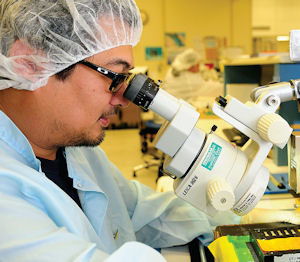Spectrolab is taking its high-flying solar cells and bringing them down to earth. After building a reputation as the supplier of advanced cells for satellites, the International Space Station and two Mars rovers, the Boeing Co. subsidiary is gearing up for a major push into land-based solar installations. The Sylmar company now has a very different challenge: competing with both traditional fossil fuels and a glut of low-cost silicon solar cells, especially those made by the Chinese, which have flooded the U.S. market in recent years. “The cost of delivering solar has to be competitive,” said Spectrolab President Troy Dawson. But the company has an advantage matched by few competitors – ultra high-efficiency solar cells. In 2009, the U.S. Department of Energy National Renewable Energy Laboratory verified that the thumbnail-size cells produced by the company reached a world record of converting 41 percent of collected sunlight into electricity. And the commercial cells it markets for space applications have an industry-leading efficiency of more than 30 percent. By contrast, typical cells used in commercial buildings have efficiencies of 15 percent to 20 percent. Spectrolab achieves it results by building what are called concentrated photovoltaic cells, which require sunlight directed by mirrors and lenses. As a result, the cells are installed in utility-scale arrays. Spectrolab does not provide the panels, mirrors or other optics needed for these arrays. However, the total cost for such a system is significantly higher than those using traditional solar cells. Currently, the cost for a concentrated photovoltaic system, or CPV, is about $3 per watt as compared to $2 for the traditional silicon flat panel solar systems, said Ed Cahill, a researcher with Lux Research in Boston who authored a report on high concentrating photovoltaics released in June. But the report forecast that the cost would come down to $2.30 by 2017, and that the global CPV market will have a 31 percent compounded annual growth rate over the next five years. The biggest growth is coming from projects proposed or under construction in China, South Africa, South America and the Middle East, as well as the Southwest United States, said Tom Cheyney, solar practice director for Impress Labs, a marketing and communications firm, and former editor of trade publication, PV Tech. “The value proposition is that CPV under the right conditions generates the most power,” said Cheyney, who nevertheless added the market is taking only “baby steps.” Few contracts Spectrolab is a subsidiary in the Network and Space Systems subdivision of Boeing Defense Space & Security, the business unit responsible for defense and aerospace. Spectrolab sales are not broken out separately. The company was founded by L.A. entrepreneur Alfred Mann in 1956 to make solar cells for the emerging aerospace industry. Today, it employs about 400 workers at its 180,000-square-foot facility on Gladstone Ave., where it also makes high-powered searchlights and industrial sensors. The terrestrial market represents just 5 percent to 10 percent of Spectrolab’s solar business, but the company would like to make it a lot more. Spectrolab closely guards its customer list but industry professionals said the company’s cells are widespread. “Their customers are everybody who makes (concentrated solar) systems,” Cheyney said. Among its known contracts are three it entered into since 2006 with Australian company Solar Systems Pty. Ltd. It has delivered cell assemblies capable of producing 360 megawatts, enough to power roughly 180,000 homes. SolFocus Inc., in San Jose, contracted with Spectrolab in 2006 for cells to power 600,000 residences and businesses. Spectrolab remains SolFocus’s largest supplier because it has the best proven product available, said Nancy Hartsoch, vice president of sales and marketing for SolFocus. “They are the dominant company,” she added. Now, as it focuses more on the terrestrial market, Spectrolab has been making improvements to its R&D and manufacturing processes that benefit both that market and its space business. The company has nearly completed the modernization of 7,000 square feet of its Sylmar facility with new automated equipment and clean rooms for producing solar cells. The small square-shaped cells are grown on round 4-inch and 6-inch wafers; the project added a production line to make the larger wafers, which contain more cells. The line is undergoing quality testing, while the completed cells are being tested by replicating the harsh space environment. The line should be in full productnio by early next year. The cells are multi-layered to capture light from different segments of the spectrum and are made from the elements germanium and gallium arsenide instead of silicon. “(Efficiency) has been the focus of the industry over the last 10 years and they have made huge headway,” said Monique Hanis, a spokesperson for the Solar Energy Industries Association, a Washington, D.C. trade group. But Boeing’s move into the terrestrial market is not a sure thing. Solyndra, a Fremont firm with a novel, cylindrical solar panel for commercial roof tops, notoriously went bankrupt last year after receiving more than $500 million in federal loan guarantees. The company blamed rapidly plummeting prices for solar panels manufactured in China. While the Boeing subsidiary doesn’t face that risk given its space business, it has competition. There are 5,600 companies in the solar business in the United States, including about 1,000 manufacturers of one kind or another, according to SEIA, the solar energy trade group. Competitors include Emcore Corp., of Albuquerque, N.M., which has a CPV joint venture with a Chinese company, and two California companies: Solar Junction in San Jose and JDSU in Milpitas. However, for the market to expand, industry observers say falling CPV prices have to come down more.
